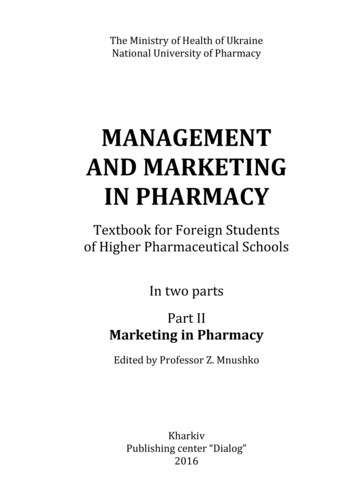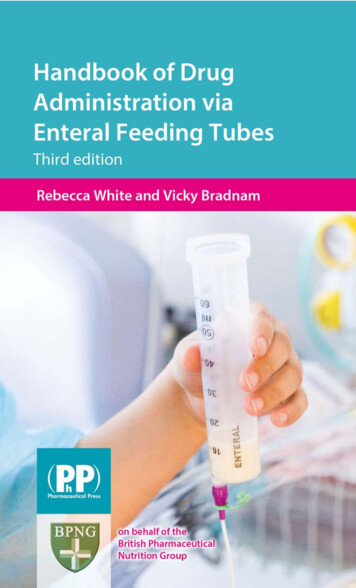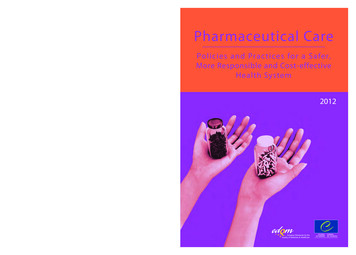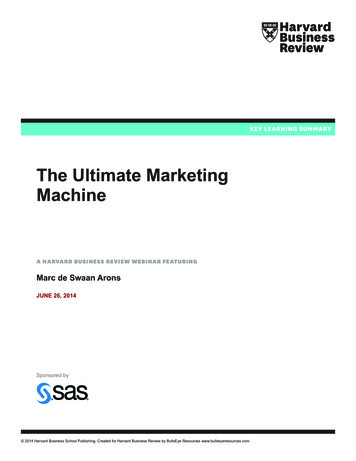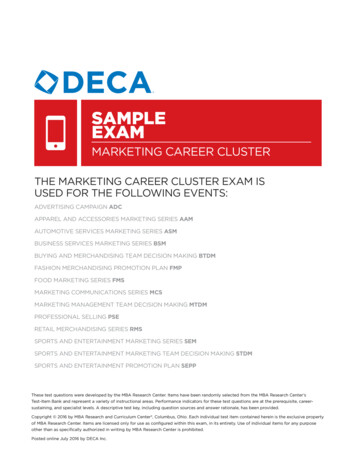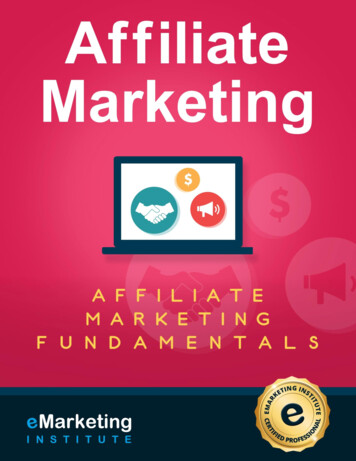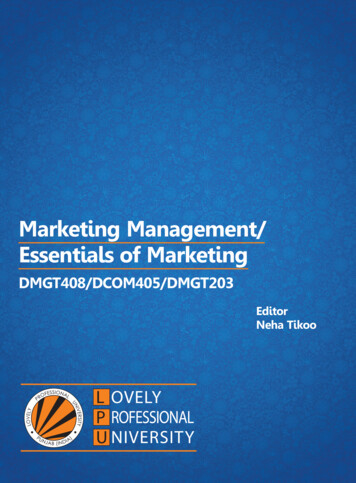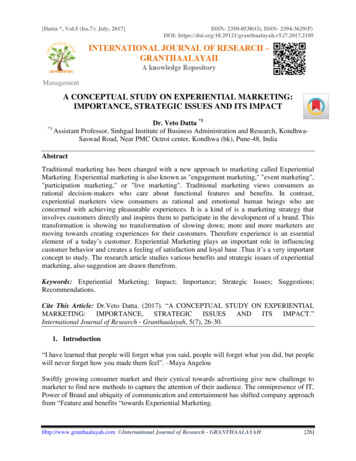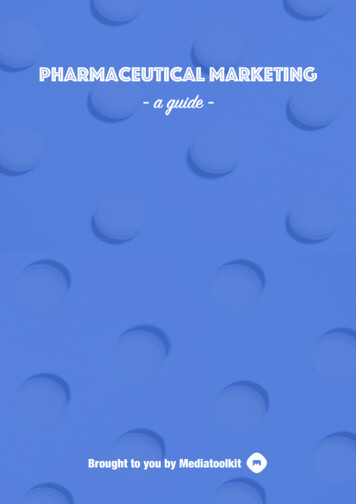
Transcription
Pharmaceutical Marketing- a guide -Brought to you by Mediatoolkit
Table of contentsChapter 01Introduction topharma marketingChapter 02The importance ofpharma marketingChapter 03Navigating thechallenges of pharmamarketingChapter 04Pharma marketer jobposition: requirementsChapter 05Pharma marketingstrategy & useful tools
1Introduction to pharma marketingThe global pharmaceutical market is expected to exceed 1.1 trillion in years to comewith a 5% growth rate. When it comes to marketing, many companies are spendingtwice as much money on marketing than they do on research and development.Marketing enables pharma companies to identify, anticipate and provide solutions forcustomer requirements.Pharma marketers have two main audiences - patients and medical professionals.According to Health Action International’s guide, pharmaceutical companies use a“multi-channel” approach to ensure the same message about products is receivedfrom different information sources.The promotional strategies they’re using include:Relationship-based Selling,Product Information and Awareness,Use of Media,Market expansion techniqueUse of Key Opinion LeaderIn this ebook, we’ll focus on the use of media, specifically on digital marketing.Going digitalPharmaceutical companies can no longer solely rely on brand name recognition or printadvertising to drive sales because of the increasing competition from generics3
1Introduction to pharma marketingmanufacturers. That’s one of the reasons why they’re turning to digital.Also, the HAI guide points out that with the rise of smart devices, both healthcareprofessionals and consumers are increasingly reliant on the internet for medicalinformation. That means investing in this new trend and replacing traditionalpromotional activities with product websites, SEO and social media campaigns.Currently, the most successful strategies are the ones combining search, video, andsocial.Statistics show that people prefer video content. 51% of marketers say that videocontent has the biggest ROI, while 59% of consumers say that if they have to choosebetween text and video on the same topic, they’ll choose video.Emphasis on the contentWhen it comes to creating content, Blue Novius states that pharma marketers need tobe aware of regulations. The HAI guide states that in the European Union there arethree regulatory arms:The EU legislative framework;Individual national laws incorporating EU provisions;Voluntary codes of conduct (self-regulation).Because of that, content produced by pharma marketers has to be in compliance withthe regulations. On top of that, products that pharma marketers are promoting directlyimpact people’s health and it’s essential that the content is verified, based on facts,clearly explained and precise.Read more on pharmaceutical marketing regulations in the third chapter (Navigatingthe challenges of pharmaceutical marketing).4
1Introduction to pharma marketingIn the 2019 MMM website asked pharma marketers what technology, media orinnovation has had the most significant impact on healthcare marketing.Their main takeaways were:AI-enabled voice search,Integration of telemedicine, digital behavioral change, and direct-to-consumerprescription deliveryRobust digital/social marketing via marketing automation systems like Marketo,HubSpot, Pardot, etc.Strong data strategyIn the coming chapters, we’ll cover content and going digital in more detail.5
2The importance of pharma marketingMany pharma marketers would argue that in the past their CEOs were not payingenough attention nor realizing the importance of marketing in the pharmaceuticalindustry.Others say that marketers are at fault because they’ve looked at their products ascommodities rather than highly differentiated brands.The fact is that marketing has a huge impact on the success of pharmaceuticalproducts if done right.Eye for Pharma gave a great example of that:“A certain brand had great clinical data on efficacy, a minimal side effect profile andstrong safety but was just failing to thrive. Two years post-launch and it still had asingle-digit market share and was not growing. When looking at the data, it didn’t looklike a particularly effective drug, so the thinking was that it would have to be positionedfor mild cases of the condition. However, when analyzing the data further, it was foundto be a highly effective drug and the marketing team had neglected to even discussefficacy as a message as they felt the fact it was launched and approved meant it washighly effective. They had decided to focus on what I would consider secondarymessages - such as ‘lack of weight gain’ - and completely neglected efficacy, whichwas the number one driver message. By changing their messaging to analyticsidentified driver messages, they were able to double their market share in 6 monthswith the same budget, something they had not been able to achieve in the precedingyears.”This shows that producing new products and placing them on the market is simply not6
2The importance of pharma marketingenough. The saturation of products in the pharma industry is high and differentiatingyour products is a must.Here’s a product that ticks all the boxes, but no one is buying it.Why?They’re not properly informed, and because of that they’re reaching for some other,familiar, and possibly tried the product. That other product may have worse stats thanthe one we’re talking about, but we can’t blame the consumers for not knowing that.Nowadays, people have myriad ways of getting the information they need. That’s whyit’s important for you to provide them with relevant and factual ones.It’s important for you to be in control of the information circulating about your products.Otherwise, someone else might. Read more about creating productive marketingstrategies in the following chapters.In order to inform your customers, you also need to know what they want and need.Thorough research should be a priority for all pharma marketers.The research will provide you with valuable data that will help you build yourmessaging.7
Navigating the challenges of pharmamarketing3The ever-growing nature of the pharmaceutical industry is undeniable. Research by TheBusiness Research Company reports the global pharmaceuticals market was worth 934.8 billion in 2017, while the forecasts suggest it will reach an incredible 1,170billion by 2021.And while the numbers do speak for themselves, those within the pharmaceutical fieldare certainly aware of how fluctuating and fragmented this industry can sometimes be.Even the single largest pharmaceutical market globally, that of the United States, isexpected to experience stagnation. According to the QuintilesIMS report, the UnitedStates market will witness a growth of just 9% in 2021, compared to 12% in 2015.It is pharmaceutical marketing that plays a huge role in the growth process. All thenewest technology trends are driving a shift towards patient-centric healthcare, and it’sup to pharma marketers to recognize the number of opportunities and innovate theirmarketing while still abiding policy reforms and managing data.In this section of our ebook, we’ll cover four of the most notable challengespharmaceutical marketing faces nowadays:1.Regulations2.Data collection3.Adapting to a patient-centric environment4.Digital transformationLet’s start!8
2The importance of pharma marketingREGULATIONSPharmaceutical products have traditionally been much more challenging for marketersthan food and beverage or clothing items, for instance. It is also an industry that hasbeen fairly conservative when it comes to the level of creativity allowed in variousmarketing campaigns and promotional efforts.The reason for that? Regulations. If you’re working in the pharma, this won’t besurprising. Be it patient privacy protection, data management or legal legislation, thepharmaceutical industry is and always will be faced with the challenge of variousregulations.Policy reforms and new regulations happen often, and there’s basically nothing thatpharmaceutical companies and organizations can do other than comply.Policy-based challenges are not something B2B nor B2C marketers are immune to.Not only do they have an impact on sales, but they also affect how businessesmarket their products. Often times, marketing efforts, initiatives, and messages willrequire altering.And although the pharmaceutical industry sometimes can’t keep up with thesechanges, regulatory organizations do track everything. This means companies andindividuals may be faced with sanctions for their marketing efforts, whether the errorswithin them are intentional or not.These regulations vary from country to country. In the United States, for example,companies must follow the standard FTC guidelines for influencer marketing ads, aswell as abide by FDA rules and the fair balance principle, which obliges companiesand individuals to list the side effects and most important risks in the main part of thedrug ad, along with its benefits.9
2The importance of pharma marketingIn an example from 2015, the FDA actually issued a letter due to the lack of completerisk information in the main part of Kim Kardashian’s Instagram endorsement forDiclegis, a morning sickness alleviating drug. After also receiving a lot of publicbacklash for not being fully transparent, the social media star changed the caption ofher post and added the missing information.It’s challenging to make something like the aforementioned Instagram captionappealing when one needs to write down major drug use risks along, which are in itselfa reason to think twice about the use of certain drugs, and not even the fact that KimK told you about them can help.Situations like these prompted the pharmaceutical industry to shy away from highscale influencer marketing on a regular basis, unlike many other industries that thriveon influencer marketing.DATA COLLECTIONAnother major challenge is the one regarding data handling, interpretation, andconsent. Certain digital technologies are omitted due to strict patient privacyprotections that limit the options of targeting individuals.Regulations like the General Data Protection Regulation (GDPR) make the lives ofmarketers in any industry a bit more complicated. Now, translate that into thepharmaceutical marketing that depends on consumer information and feedbackand the situation gets even more tricky.On that note, a report by Econsultancy suggests the majority of healthcareorganizations are not even prepared to deal with emerging data sources or tocollect high volumes of data.10
2The importance of pharma marketingDeveloping patient insight from emergingdata sources (i.e. wearables, etc.) andintegrating into marketing programsCollecting/managing very high volumes ofdata quicklyDeveloping patient insight from existing datasources (CRM, medical databases, etc.) andintegrating into marketing g very high volumes ofdata securely10%22%Developing policies in line with privacyregulation for gathering, permissioning andusing it correctly9%28%5%8%50%50%47%6%18%17%Source: EconsultancyAccording to this research, 66% of respondents are not prepared for developingpatient insights from emerging data sources and integrating them into marketingprograms, while the speed of data collection presents an issue for 53%.Developing policies in line with privacy regulation for gathering, permissioning andusing it correctly is something one-third of respondents are (very) unprepared for. Giventhe severity and responsibility of handling such delicate information collected from theconsumers, this is an alarming situation, especially since more and more people arebecoming much more aware of the third-party usage of their information online.The pharmaceutical industry is yet to recognize the enormous potential newtechnologies such as wearables have. Wearables are smart electronic devices (mostpopularly smartwatches) that can be incorporated into clothing or worn as accessoriesand used to track physical activity, sleep patterns and heart-rate. They provide valuabledata about patients’ behavior and habits, while some go as far as recognizingpotentially dangerous heart conditions.11
2The importance of pharma marketingIt is estimated that almost half of adult wearable users regularly wear asmartwatch and that number will only increase. In fact, a report by eMarketersuggests that a quarter of the US population will use a wearable at least once a monthby 2022. That is a whopping number of 67 million people providing their lifestyleand health data.Other than wearables, new technologies also include the likes of CustomerRelationship Management (CRM) software. CRMs provide data suitable forintegration in marketing campaigns, yet 44% of the aforementioned respondents arestill not prepared to use the CRM data for patient insight.ADAPTING TO PATIENT-CENTRIC ENVIRONMENTSpeaking of technological advancements and trends, there is one that should interestpharmaceutical marketers in particular - the shift to a patient-centric environment.Pharmaceutical companies should always tend to find new ways to better resonatewith their audience, educate their patients and build confidence in their products moreeffectively. To do so, they need to know where and how their patients prefer to receivethat information.For a long time, patients relied solely on healthcare practitioners for information, but thefact is that patients are nowadays not so dependent on doctors and pharmacistsand often seek health-related guidance online.A study by Pew Research suggests 90% of people aged 18-24 trust medicalinformation on social media. Furthermore, a whopping third of the adult USpopulation goes online to ‘figure out’ a medical condition.As a result, patients are more likely to take an active role in any treatment plan their12
2The importance of pharma marketingdoctor may prescribe. That is the exact reason why direct consumers might becomepharmaceutical companies’ most strategic partners and shift the focus frompartnerships with the medical community.Patients are also active in an increasing number of digital channels and becoming moreand more in control of their digital experiences, making targeting andpersonalization a more complex but potentially rewarding task for marketers.According to research, 59% of U.S. online shoppers expect their healthcarecustomer service to be as good as Amazon. This is why the main basis on whichpharmaceutical marketers compete nowadays is providing the ultimate customerexperience (CX).Not only are customers more informed than ever, but they also seek new valuebenefits; new drugs and therapies that are better than anything on the market. Thepharmaceutical industry will have to foster a relationship with the public and develop apatients-first approach, as they play an ever-increasing role in the success ofpharmaceutical products.DIGITAL TRANSFORMATIONEvery aspect of marketing is impacted by technology, and pharmaceutical marketing isno exception. Although new technologies are challenging in the sense that they comeand go so fast, there are some that have the potential to revolutionize the pharmamarketing sector.Big data and artificial intelligence have completely changed the digital landscape,while the use of new and emerging technologies constantly provides competitiveadvantage and aid in branding and differentiation.13
2The importance of pharma marketingOne of the key aspects the digital revolution has brought to the business world isadvanced data analytics, which enables pharmaceutical companies to gain valuableinsights and implement them into various stages of R&D, as well as marketing andsales.However, the complexity of analyzing such vast amounts of data can be demanding hence the reason why some pharmaceutical companies turn to machine learning tohandle the task. Machine learning, a part of artificial intelligence, is focused onanalyzing data using computer systems, recognizing patterns, and learning from thatdata. In conjunction with large amounts of information, this results in what is oftenreferred to as big data.Another major buzzword is IoT - the Internet of Things. It enables data to beprocessed not only in the cloud but also in small gadgets such as the aforementionedwearables themselves in real-time. Being able to adapt to that information as theyappear would be a huge step forward for the entire industry, and all the predictionssuggest that IoT will be key in the imminent future.DRUG DISCOVERY& DEVELOPMENTMANUFACTURING& SUPPLY CHAINOrgan in a chipdevices to run real-lifediagnostics scenarioWearable devices forsubjects with sensorsfor real-time healthreportingUse of sensors anddevices to monitorclinical sites, subjectsscreening and realtime reportingUse of Auto-ID withAIDC (automatedinformation datacollection) for smartserialisationReal-time logisticsvisibility using RFID &sensors to captureand report parametersincluding temperatureSmart warehousingand routingPredictivemaintenance ofmachines & equipmentSALES &MARKETINGDrug interactionchecker - Interactiveecosystem with HCPsusing databaseencompassing NFCand allergy detectionto preemptivelydiscover adverse drugreactionsPATIENTACCESSWearable devicesChip in a PillSmart pill withdose variablizationDrug usagetracking andmedicationcomplianceIoT Application Across Pharma Value Chain, source: Wipro14
2The importance of pharma marketingIf more pharma companies used these technologies, they would be able to gather andanalyze patient data more effectively. Thus, pharma could design personalizedtreatments and furthermore cater to the needs of their patients while also increasingthe drug effectiveness and the likelihood of its use.As for pharmaceutical marketing, knowing the exact needs of a certain target groupcould be of tremendous value in all stages of marketing a product.Pharma marketers now face a challenging decision of whether to invest time andmoney into researching new technologies and then wisely choosing those that wouldreturn the investment and give an edge over the competition in the traditionally slowpaced pharmaceutical industry.With so many options available, it may be difficult to determine where to even begin. Inthe last chapter of this ebook, we’ll cover the most successful pharma marketingstrategies you can implement right now to improve your marketing efforts.15
4Pharma marketer job position:requirementsGiven the constant development and innovation in the pharmaceutical industry, amarketing job in such a field makes for an exciting career choice.Not every marketer out there will brave the challenges of the ever-changingpharmaceutical landscape, but those that do thrive in an abundance of areas forgrowth and professional development.In this section of our ebook, we’ll dive deeper into the required qualifications,knowledge, and skills to see what differentiates pharmaceutical marketers fromothers in the marketing field.JOB DESCRIPTIONTasks of a pharmaceutical marketer can vary, depending on the position and role,as well as the organization of employment itself. Most often, the main activities apharma marketer will conduct are:Product and service promotion,Creating and implementing marketing plans with an aim to achieve thecompany's goals and to respond to customers' needs according to legal andethical principles,Working with cross-functioning teams and external partners such as vendors,Identifying and analyzing competition and new target markets,Providing support to sales programs and customer relations,16
4Pharma marketer job position: requirementsParticipating in the organization of events, trade-show activities, presentations,and other marketing-related events,Maintaining professional cooperation with pharmacists, doctors, and keyopinion leaders,Educating, communicating, and informing prospects and clients.KNOWLEDGEPharmaceutical marketing is a very interdisciplinary job. One should:Be very well acquainted with many aspects of health science,Possess an understanding of the pharmaceutical industry and knowledgeabout the development, production, and quality control of pharmaceuticalproducts,Be an innovative multi-channel marketer and create demand in order toachieve sales,Have basic business knowledge regarding the development of businessstrategies, budgeting, strategic planning, and resource allocation.SKILLSSkills-wise, a pharmaceutical marketer should have:Strong interpersonal and organizational skills,Strong communication skills (presentation, verbal, and written abilities),17
4Pharma marketer job position: requirementsAbility to work with and manage cross-functional teams,Ability to manage multiple projects and priorities,A detail-oriented and analytical mindset with critical thinking skills,Willing to constantly learn and grow professionally.Qualifications and experienceA bachelor’s degree or an MBA is traditionally required, while the field of study canvary. Most often, pharmaceutical companies look for a university degree in Pharmacy,Medical Science or Veterinary Medicine.Experience is another aspect that is predominantly a must. The majority of companiesexpect a person to have experience in marketing methods and techniques, as well asa hands-on experience within the industry.18
5Pharma marketing strategy & useful toolsPHARMA MARKETING STRATEGYPharma marketing is steadily making its transition from one-channel, traditionalmarketing practices to multi-channel approach. The change was required due tothe rise of digital and changing consumer expectations. Nowadays, consumers areaccessing information in a multitude of ways, using different online platforms. Gone arethe days of TV and print ads being the only source of information and advertisingopportunity.In fact, the shift to digital has notably been predicted to rise by 14.1% this year,while TV will grow by a mere 0.8%.Forever burdened by the many regulations and restrictions (however rightfully in place),pharma marketers are always facing obstacles when wanting to market their products.However, digital has broadened the horizons of pharma marketing and made way fornew marketing opportunities.To gain competitive advantage, pharma marketers are embracing the digitaltransformation and making use of all the newest channels - including social media,apps, and video.In this chapter, we offer a look into nine new channel tactics you can employ in yourpharma marketing strategy.19
2The importance of pharma marketingClick on the subsection to skip right to it.#1 Messaging apps & chatbots#2 Influencer marketing#3 Video marketing#4 Social media presence#5 Content marketing#6 Unbranded content#7 Voice search#8 Virtual reality#9 Media monitoring & social listeningPharma marketing useful tools20
2The importance of pharma marketing1 MESSAGING APPS & CHATBOTSThese two are on the rise and a convenient way of bringing AI into pharma marketing.Especially with today’s NLP-based chatbots that have an ability to learn frominteractions, growing more accurate over time. What exactly is in it for pharmamarketers, though?Let’s start with a couple of statistics. One survey has shown that more than 85% ofpatients were confident in their ability to take responsibility for their health. Meaningthey are learning to be less dependable on actual doctors. Another survey has shownthat 37% of Americans would use a chatbot in an emergency.Many big pharma names are getting in on the apps & bots game - from Pfizer toTeva. It’s a way for pharma companies to spark up conversations with their (potential)customers, engage with them and gather valuable information first-hand.It also plays a significant role in automated marketing activities, as chatbots can bethere 24/7 for patients’ questions and inquiries. Whether it’s about dosages,instructions, usage, advice - they can provide medical information for patients andautomate repetitive processes.Here are a few examples:#1 Johnson & Johnson: AndyAndy is an AI-powered virtual assistant for contact lenses that connects to theFacebook Messenger app. It takes a consumer through a customer journey ofJohnson & Johnson ACUVUE contact lenses. It is made for those considering wearingcontacts for the first time, as well as those who already wear them. It also serves as aplace where they can get advice and form healthy contact-wearing habits.21
2The importance of pharma marketingAndy, source: Vision Monday#2 Amag Pharmaceuticals: sexual health chatbotAmag has developed a chatbot that allows women to inquire about sexual health and,more precisely, pain experienced during intercourse. This way they’ve created a safespace for women to anonymously get more information as well as learn more aboutIntrarosa (Amag’s medicine for treating the aforementioned pain).Amag chatbot, source: PM36022
2The importance of pharma marketing#3 Teva: MaxbotThis chatbot won two Pharmaceutical Marketing Society awards in 2018. It connectsto the Facebook Messenger app and serves as a digital brand ambassador for Teva’sinhaler through which patients can discuss its usage and benefits.Teva Maxbot, source: Teva UK2 INFLUENCER MARKETINGAccording to one research, 90% of young people trust the information they see onsocial media. Additionally, a third of the US adults opt to go online to research amedical condition.The foundation for beneficial influencer marketing practice in pharma is there. However,pharma marketers were still a little wary to make that transition. The reluctance wasmainly a result of the FDA regulations which mandate that pharma ads list possiblerisks and side effects of the product, as well as at least one approved use. Additionally,pharma influencers need to emphasize the connection between them and the brand(which is usually done by using the hashtag #ad and variations thereof). If thoseconditions are not met, both the pharma company and the influencer can findthemselves in trouble (remember Kim Kardashian’s post for Diclegis).23
2The importance of pharma marketingTherefore, pharma marketers have to be more careful about who they’re working withand make sure it is someone who’s authentic and transparent in their approach. That’swhy, when they opt for using influencers, pharma marketers tend to lean towards nicheinfluencers. People with a smaller following and reach, but with a bigger impact andengagement rate. Those are mostly doctors or nutritionists, fitness experts - peoplethat are actually relevant to an advertised subject and respected in their areas.Influencer marketing is especially successful if a person sponsoring a pharma initiativeor treatment is personally involved in the issue or has experienced it. People are moretrusting towards influencers who they feel have a valid reason to sponsor a certainproduct and can easily empathize with. It’s all about storytelling and creating anemotional connection with the audience.Here are a couple of examples of successful influencer-pharma marketer relationships:#1 Amcal Pharmacy & Jack PerkinsAmcal Pharmacy collaborated with a race car driver Jack Perkins who suffers fromdiabetes. He documented his personal journey with the disease and how Amcalpharmacy helped him manage it and get the medication he needs - all withoutpromoting a specific product. Rather, the sponsored post was meant to raise diabetesawareness.Amcal & Jack Perkins collaboration, source: Jack Perkins’ Instagram post24
2The importance of pharma marketing#2 Novartis & Queen LatifahNovartis, who produce a drug to treat heart failure, teamed up with Queen Latifahduring World Heart Day to discuss and raise awareness of the illness. Inspired by hermother’s own heart failure experience, Queen Latifah has been passionate aboutbringing this subject to life in a Facebook Live panel discussion. For Novartis, followinga poorly received campaign for their medicine Entresto, this was a more empatheticand heartfelt approach to awareness campaigning. This way, they’ve wanted to reacha wider audience in real-time and encourage live engagement.Check out the promo video starring Queen Latifah and her mother here.Both collaborations exhibit emotional connectedness to the cause andstorytelling aspects. Both Jack Perkins and Queen Latifah have been personallyaffected by sponsored illnesses and that made them convincing, credibleambassadors with whom people can empathize. That is what you need to strive for inpharma influencer marketing. Don’t be hasty in choosing the influencer with thebiggest following. Rather, make sure the influencer is relevant to your product, initiative,and brand.3 VIDEO MARKETINGAs we’ve already mentioned in the introduction, 51% of marketers say that videohas the highest ROI of all content formats. Not only that, but viewers retain 95%of the message when watching a video.These are compelling data that highlights the importance of video as a marketingformat. Whether it’s through social media, website, email or other channels - videos arean advantageous tool in raising engagement, capturing attention and delivering easilydigestible information. Not only does this ring true for patients, but also physicians. Infact, physicians themselves spend around three hours a week watching videos, andthey prefer videos to reading medical publications or listening to rehashed data from a25
2The importance of pharma marketingsales rep. Additionally, 49% of physicians who watch online videos state that itinfluences their clinical decision.Patients, too, want to take in as much information as possible in a short time. Theywant that information to be easy to retain and understand, as well as entertaining.Explainer videos are a popular way of accomplishing this. They are short and concise,meant to simplify a complex subject. With explainer videos, you can introduce aproblem (an illness) and offer a solution for a viewer (e.g. your product/service).Here are a few examples of successful use of video in pharma mark
1 Introduction to pharma marketing The global pharmaceutical market is expected to exceed 1.1 trillion in years to come with a 5% growth rate. When it comes to marketing, many companies are spending twice as much money on mar

